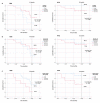Optimal Extent of Neck Dissection for a Head and Neck Lymph Node Metastasis from a Remote Primary Site
- PMID: 38337356
- PMCID: PMC10856640
- DOI: 10.3390/jcm13030661
Optimal Extent of Neck Dissection for a Head and Neck Lymph Node Metastasis from a Remote Primary Site
Abstract
Background: Despite its rarity and limited documentation, therapeutic neck dissection (ND) for cervical lymph node (LN) metastases from distant primary sites is increasingly practiced, potentially enhancing survival rates. However, the optimal ND extent remains unclear. This study aimed to determine the safety of excluding upper neck levels from ND.
Methods: We retrospectively analyzed 25 patients who underwent ND for cervical LN metastases from remote primary tumors between 2015 and 2021 (12 with primary lung tumors, four with ovary, three with mammary gland, three with esophagus, two with thymus, and one with colon).
Results: Assessing clinical characteristics and occult metastasis rates, we observed LN metastases predominantly at levels III and IV. Occult metastases occurred in 14 out of 25 patients, primarily at neck levels III and IV (55.0% and 50.0%, respectively). The five-year disease-specific survival rate for all patients was 44.3%. While no statistically significant impact of occult metastasis on prognosis was confirmed, an association between the postoperative LN ratio and poor prognosis was revealed.
Conclusions: Our findings suggest that prophylactic NDs at levels I, II, and Va may not be essential for managing cervical LN metastases from remote primary malignancies. This could lead to a more tailored and less invasive therapeutic strategy.
Keywords: cervical lymph node metastasis; occult metastasis; optimal neck dissection extent; remote primary; survival.
Conflict of interest statement
The authors declare no conflicts of interest. The funders had no role in the design of the study; in the collection, analysis, or interpretation of data; in the writing of the manuscript; or in the decision to publish the results.
Figures




Similar articles
-
Neck Dissection for Cervical Lymph Node Metastases from Remote Primary Malignancies.Medicina (Kaunas). 2020 Jul 10;56(7):343. doi: 10.3390/medicina56070343. Medicina (Kaunas). 2020. PMID: 32664344 Free PMC article.
-
Role and Extent of Neck Dissection for Neck Lymph Node Metastases in Differentiated Thyroid Cancers.Sisli Etfal Hastan Tip Bul. 2021 Dec 29;55(4):438-449. doi: 10.14744/SEMB.2021.76836. eCollection 2021. Sisli Etfal Hastan Tip Bul. 2021. PMID: 35317376 Free PMC article. Review.
-
Patterns of Occult Metastasis to Level Va and Vb in Clinically Lateral Node-Positive Papillary Thyroid Carcinoma.Ann Surg Oncol. 2022 Apr;29(4):2550-2556. doi: 10.1245/s10434-021-11085-9. Epub 2021 Nov 18. Ann Surg Oncol. 2022. PMID: 34792697
-
Individualized optimal surgical extent of the lateral neck in papillary thyroid cancer with lateral cervical metastasis.Eur Arch Otorhinolaryngol. 2014 Jun;271(6):1355-60. doi: 10.1007/s00405-013-2630-x. Epub 2013 Jul 16. Eur Arch Otorhinolaryngol. 2014. PMID: 23857026 Review.
-
[Jugular neck dissection for supraglottic laryngeal carcinoma with negative clinical findings in the neck (N0)].Srp Arh Celok Lek. 2004 Mar-Apr;132(3-4):73-5. doi: 10.2298/sarh0404073p. Srp Arh Celok Lek. 2004. PMID: 15307306 Serbian.
Cited by
-
When neck lymph nodes metastases do not origin from a head and neck unknown primary.Curr Opin Otolaryngol Head Neck Surg. 2025 Apr 1;33(2):102-108. doi: 10.1097/MOO.0000000000001031. Epub 2025 Jan 22. Curr Opin Otolaryngol Head Neck Surg. 2025. PMID: 39838587 Free PMC article. Review.
References
-
- Schiff B.A., Roberts D.B., El-Naggar A., Garden A.S., Myers J.N. Selective vs Modified Radical Neck Dissection and Postoperative Radiotherapy vs Observation in the Treatment of Squamous Cell Carcinoma of the Oral Tongue. Arch. Otolaryngol. Head Neck Surg. 2005;131:874–878. doi: 10.1001/archotol.131.10.874. - DOI - PubMed
-
- Larsen M.H., Lorenzen M.M., Bakholdt V., Sørensen J.A. The prevalence of nerve injuries following neck dissections—A systematic review and meta-analysis. Dan Med. J. 2020;67:A08190464. - PubMed
LinkOut - more resources
Full Text Sources

